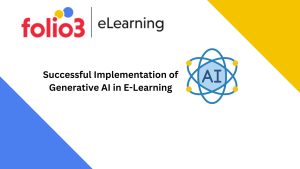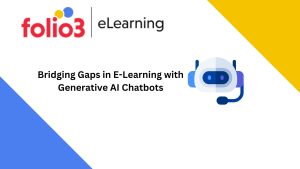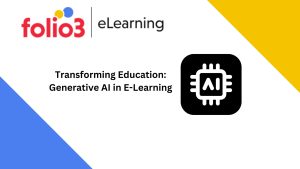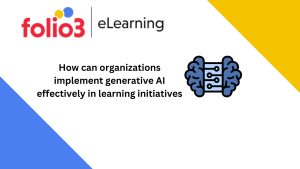
Executive Summary:
Revolutionize education with Generative AI in E-Learning, which offers tailored learning experiences, streamlines material generation, and improves accessibility. This technique creates text, and even multimedia material using enormous volumes of data.
Introduction:
The inevitable advance of technology has caused a fundamental alteration in the face of education. The use of Generative AI in E-Learning is one of the most significant advances in this evolution, and it has the potential to fundamentally alter how we teach and learn.
The combined use of Generative AI in E-Learning stands as a beacon of innovation in this age of fast digitization, altering educational paradigms, and transforming education as we know it.
In this blog, we’ll look at the effects of generative AI in E-Learning and how it’s changing how we learn new things.

Generative AI in E-Learning
Creating content has never been easier thanks to generative AI, a branch of artificial intelligence.
Generative AI goes beyond conventional AI systems’ primary focus on data processing and analysis by producing material that is both authentic and intensely pertinent to the environment in which it is used.
- Personalized Learning Experiences:
One of the most amazing results of using Generative AI in E-Learning is the capacity to customize educational content for specific students.
Generative AI has the ability to assess each learner’s strengths, limitations, and rate of learning, in contrast to traditional classroom environments that frequently struggle to meet the different needs of pupils.
It then customizes the information distribution to offer a customized learning environment. This increases comprehension and retention rates while also encouraging higher involvement, making education more effective and efficient.
- Language Support:
Language hurdles in education may be overcome by generative AI’s multilingual ability. This technology is adept at quickly and precisely translating text into a variety of languages. Because of this, anyone, anywhere can access educational resources, regardless of their language proficiency.
This function is especially useful for fostering diversity in schooling. It makes it possible for students from all linguistic backgrounds to access the same excellent educational materials.
Additionally, it promotes cross-cultural learning opportunities, creating a more connected and conscious generation of learners.
- Improved Assessment
The way assessments are carried out in e-learning environments could be completely changed by generative AI. The creation of creative assessment systems that automate the grading process is one noteworthy achievement.
These applications use AI algorithms to quickly and accurately analyze student submissions, including essays, assignments, and quizzes.
Systems for automated grading let teachers significantly reduce their workload. Instructors can concentrate on more involved teaching and mentoring activities rather than spending hours manually evaluating and grading student work.
This change in their position may result in deeper contact with students and a stronger focus on promoting learning.
- Supporting a Range of Learning Styles
It might be difficult for teachers in typical educational environments to accommodate students’ various learning styles.
While some learners are auditory and benefit most from lectures and debates, others are visual and prefer graphical representations and diagrams. On the other hand, kinesthetic learners learn better through practical experiences and hands-on exercises.
Generative AI in E-Learning can produce diagrams, infographics, and films that visually explain complicated subjects for students who prefer visual content. For this population, visual aids improve comprehension and recall.
- Cost-Efficiency
Long-term cost savings can be significant when implementing generative AI in e-learning. The technology’s capacity to generate and deliver information at scale might lessen the need for significant human resources in content production and delivery, even though there may be early setup and development expenditures.
In the past, producing instructional content, especially high-quality resources, may have been a time- and resource-intensive operation.
Automating the generation of content, generative AI efficiently produces text, graphics, and multimedia elements. As a result, a huge crew of content producers is not as necessary.
Transforming Education with Generative AI
Generative AI in e-learning aims to enhance the educational experience while also supporting the idea of lifelong learning. The concept of continuous learning holds that education should last throughout a person’s life, not just during the traditional school years.
This idea is improved in various ways by generative AI:
- Skill Adaptation:
Our world is changing so quickly that skills are becoming obsolete at an astounding rate. By spotting emerging patterns and promoting skill development, generative AI can play a crucial role in aiding people in adapting to this changing environment.
Large volumes of data from numerous sources, such as industry reports, market trends, and scholarly research, can be analyzed by generative AI.
It can identify changing employment markets and emerging skill requirements. Individuals can proactively get ready for new possibilities and sectors by staying on top of current developments.
- Continuous Growth:
The ability of generative AI to continuously analyze data and adapt aids in the advancement of the educational process.
Generative AI can pinpoint areas in which instructional materials can benefit from change by examining data on how students interact with the information. To improve the entire learning process, it can modify the exercises’ degree of difficulty, clarify explanations, or offer other resources.
Generative AI can adapt course content and delivery strategies dynamically in response to changes in student preferences and needs.
For instance, the AI can change the content or recommend alternate learning paths if a particular module achieves low engagement or comprehension rates in order to better fulfill individual learning goals.
- Cross-disciplinary Learning Facilitation:
The capacity of generative AI to dissolve knowledge barriers between many disciplines allows students to easily investigate subjects that cut across boundaries.
It can be difficult for people to obtain content from unrelated subjects in traditional education.
Interdisciplinary courses and materials that combine knowledge from various fields can be created via generative AI. A multidisciplinary approach is necessary for many real-world problems.
Conclusion:
Education is being transformed by generative AI in e-learning because it offers tailored learning experiences, streamlines material generation, and increases accessibility. With the help of this technology, people can continue to learn new things throughout their lifetimes, supporting the idea of lifelong learning.
However, it is crucial to proceed cautiously with the implementation of Generative AI in e-learning, addressing ethical considerations and making sure that technology enhances rather than replaces the function of human educators.





